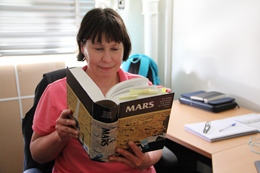25 September 2014
 Images of Mars beamed to Earth by satellites orbiting the planet and by landers (including Curiosity) show a world which, though barren, keeps everyone guessing: could life have once existed there?
Images of Mars beamed to Earth by satellites orbiting the planet and by landers (including Curiosity) show a world which, though barren, keeps everyone guessing: could life have once existed there?
It’s a question that Graziella Caprarelli, Associate Professor in Space Science at UniSA, is likely to face and is most qualified to answer, as she delivers a keynote speech in the Mars symposium session of the forthcoming 2014 Australian Space Research Conference.
The conference will be drawing the Australian space science community to City West campus next week, with a focus on space research, policy and operations, a highlight of which is expected to be Caprarelli’s talk on September 30th.
As a scientist whose research interests include the exploration of extra-terrestrial planets, Caprarelli is an expert in being able to read the Martian landscape like a jigsaw puzzle, piecing together what processes led to its formation.
Using her expertise in Earth-bound volcanic activity and hydrothermal circulation, Caprarelli applies that knowledge to interpret streams of data that NASA and European Space Agency missions are sending back from Mars.
Caprarelli’s research has shown that lava flowed on Mars not only from the massive volcanoes, such as Mts Olympus and Elysium, but also from subtle features such as fissures on the ground.
“As a theoretician, I use numerical values and spectral analysis to infer how the features on the surface of Mars came to be there, what type of processes were involved, not only volcanic but also hydrological,” says Caprarelli.
“My speech at the conference will be on new ways to analyse the statistics of impact craters to figure out the ages of various parts of Mars.”
This is useful not only to understand the geology of Mars and how it formed, but also to understand a bit more about how the Solar System formed.
“Mars has been observed a lot, we have a lot of data on that planet, so it’s possible to test models on this data – like using Mars as a blueprint to understand more about our own Solar System.”
Given the huge amounts of data that now exist on Mars and the relative lack of scientists who are studying that data, Caprarelli is keen to encourage more people to become involved in the study of the Red Planet.
“A lot of things can be done with Mars data sets; in fact some of my colleagues have run successful school programs in Sydney where school kids have collected data and have presented their results at conferences.
“Mars is becoming more familiar, it looks like central Australia in many ways and people can relate to Mars. They can also become involved in learning more about the planet.”
One way to learn more about Mars is through the Mars Public Talk that will be presented by Dr Penny King (Australian National University), member of the Curiosity scientific team. The Public Talk will be held on Monday September 29, at 7:00 pm, in the Allan Scott Auditorium (Hawke Building).
The conference website provides information about the conference, the venue, the program, and the Public Talk.
Contact for interview: Graziella Caprarelli office (08) 830 21870 email Graziella.Caprarelli@unisa.edu.au
Media contact: Will Venn office (08) 8302 0096 email will.venn@unisa.edu.au


